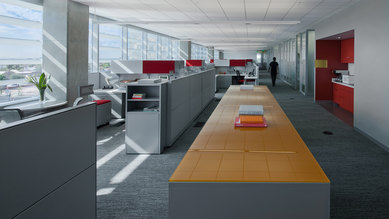Energy Efficient Lighting
High Performance Lighting Looks to Nature
The need for energy efficient lighting has become mainstream. Momentum is growing at the consumer level for light sources that save energy and protect the environment. Even as consumers attempt to improve lighting in their homes, the possibilities within commercial environments may be even greater. Exploring opportunities to maximize the use of abundant daylight, utilize energy saving light sources such as LEDs, and provide enhanced lighting controls are some of the strategies that help achieve the prospect of high performance building design.
Chandler City Hall is one project that demonstrates an exceptional blend of high performance lighting. Composed primarily of glass and metal, the five-story office building represents a progressive attitude and an expression of technology, much of which lies inside the building skin.
To address the building’s highly-glazed exterior and mitigate impact of the intense Arizona sun, external blade louvers were designed to control heat gain and glare for work areas. Twenty-five variations of blade depth, spacing and tilt were analyzed to maximize interior illumination, reduce glare, preserve the view of mountains, and reduce material blade costs. In the open office areas, significant energy savings were achieved by efficiently balancing available daylight with electric lighting, as needed. Photosensors integrated into indirect lighting fixtures automatically dim lighting levels to maximize energy savings and extend lamp life.
An efficient lighting design utilizing ambient lighting from indirect, high efficiency fluorescent fixtures was matched with the personal control offered by LED task lighting at work stations. This task-ambient lighting strategy provided enhanced energy savings opportunities while maximizing occupant satisfaction.
Other design strategies utilized in the facility to minimize lighting energy consumption included exterior LED lighting, tubular skylights, occupancy and photosensor controlled garage lighting, and other high efficiency light sources. Through the appropriate combination of these various approaches, the building achieves nearly 40% whole building energy savings below energy code.
